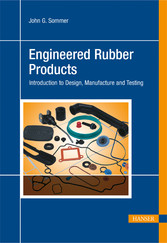John G. Sommer
Engineered Rubber Products
Introduction to Design, Manufacture and Testing
Acknowledgments
6
Preface and Disclaimer
8
Contents
10
1 Introduction
14
References
25
2 Elastomers and Compounds
28
References
36
3 Compound Mixing and Processing
38
3.1 Calendering
42
3.2 Extrusion
42
3.3 Molding
45
3.3.1 Compression Molding
47
3.3.2 Transfer Molding
52
3.3.3 Injection Molding of TPEs
60
References
62
4 Testing and Properties
64
4.1 Measuring Viscosity and Scorch
65
4.2 Hardness
67
4.3 Stress-Strain Properties
67
4.3.1 Uniaxial Deformation
67
4.3.2 Biaxial Deformation
69
4.3.3 Triaxial Deformation
71
4.3.4 Triaxial Tension
73
4.4 Viscoelastic Properties
77
4.4.1 Creep
78
4.4.2 Stress Relaxation
78
4.4.3 Compression Set
78
4.5 Dynamic Properties
79
4.5.1 Fatigue and Cut Growth
81
4.5.2 Tensile Failure
82
4.5.3 Hysteresis and Resilience
82
4.5.4 Abrasion
83
4.5.5 Friction
83
4.6 Other Rubber Properties
84
4.6.1 Effect of Test Temperature
84
4.6.2 Conductivity
85
4.6.3 Adhesion
85
4.6.4 Permeability
86
4.7 Deterioration
86
4.7.1 Weather
86
4.7.2 Ozone
87
4.7.3 High-Energy Radiation
87
4.7.4 High Temperature
87
4.8 Rubber Ingredient Compatibility
88
4.9 Electrical Properties
90
4.10 Non-Destructive Testing
90
4.10.1 Testing and Computers
90
References
92
5 Product Design
96
5.1 Mountings
97
5.2 Hose
104
5.3 Belting
107
5.4 Constant Velocity Joint (CVJ) Boots
108
5.5 Mounts and Bearings
109
5.5.1 Shape Factor
109
5.5.2 Bridge Bearings
109
5.5.3 Earthquake Bearings
110
5.5.4 Testing and Quality Control
111
References
117
6 Use of Computers and FEA with Rubber
122
6.1 Compounding
124
6.1.1 Vulcanization
124
6.1.2 Compound Development
124
6.2 Stress in a Dumbbell Tensile Specimen
124
6.3 FEA and Thermal Considerations
126
6.4 Resistance of Rubber to Small Indentations
126
6.5 Use of FEA in Various Application Areas
126
References
131
7 Non-Tire Products
134
7.1 Adhesion
134
7.2 Hose and Belting
136
7.2.1 Hose
137
7.2.2 Belts
138
7.3 Mountings, Bearings, and Bushings
140
7.3.1 Mountings
140
7.3.2 Bearings
141
7.4 Energy Storage and Dissipation
144
7.5 Rolls
145
7.6 Seals
145
7.6.1 Pump Seal
146
7.6.2 Automotive Transmission Seals
147
7.6.3 Casket Seals
147
7.6.4 Automotive Door Seals
147
7.7 Other Applications
148
References
151
8 Tires
156
8.1 Introduction
156
8.2 Materials
157
8.3 Pneumatic Tires
158
8.3.1 Types of Tires
158
8.4 Tire Reinforcement
162
8.4.1 Bead Wire and Tire Cord
162
8.5 Tire Construction
163
8.6 Component Interdependence
165
8.7 Component Preparation and Tire Fabrication
166
8.7.1 Component Preparation
166
8.7.2 Fabrication
167
8.8 Tire Aging
171
8.9 In-Service Tire Damage and Safety
171
8.10 Run-Flat Tires
172
8.11 Passenger Tire Design
173
8.11.1 Aspect Ratio
173
8.12 Truck Tires
174
8.13 Very Large Tires
175
8.14 Aircraft Tires
175
8.15 Solid Tires
176
8.16 Semi-Pneumatic Tires
176
8.17 Non-Traditional Tires
176
References
178
Appendix 1: Conversion Factors
182
Appendix 2: Acronyms and Abbreviations
184
Subject Index
188
© 2009-2024 ciando GmbH
 Zu Hanser-Fachbuch.de
Zu Hanser-Fachbuch.de
 Warenkorb
Warenkorb
